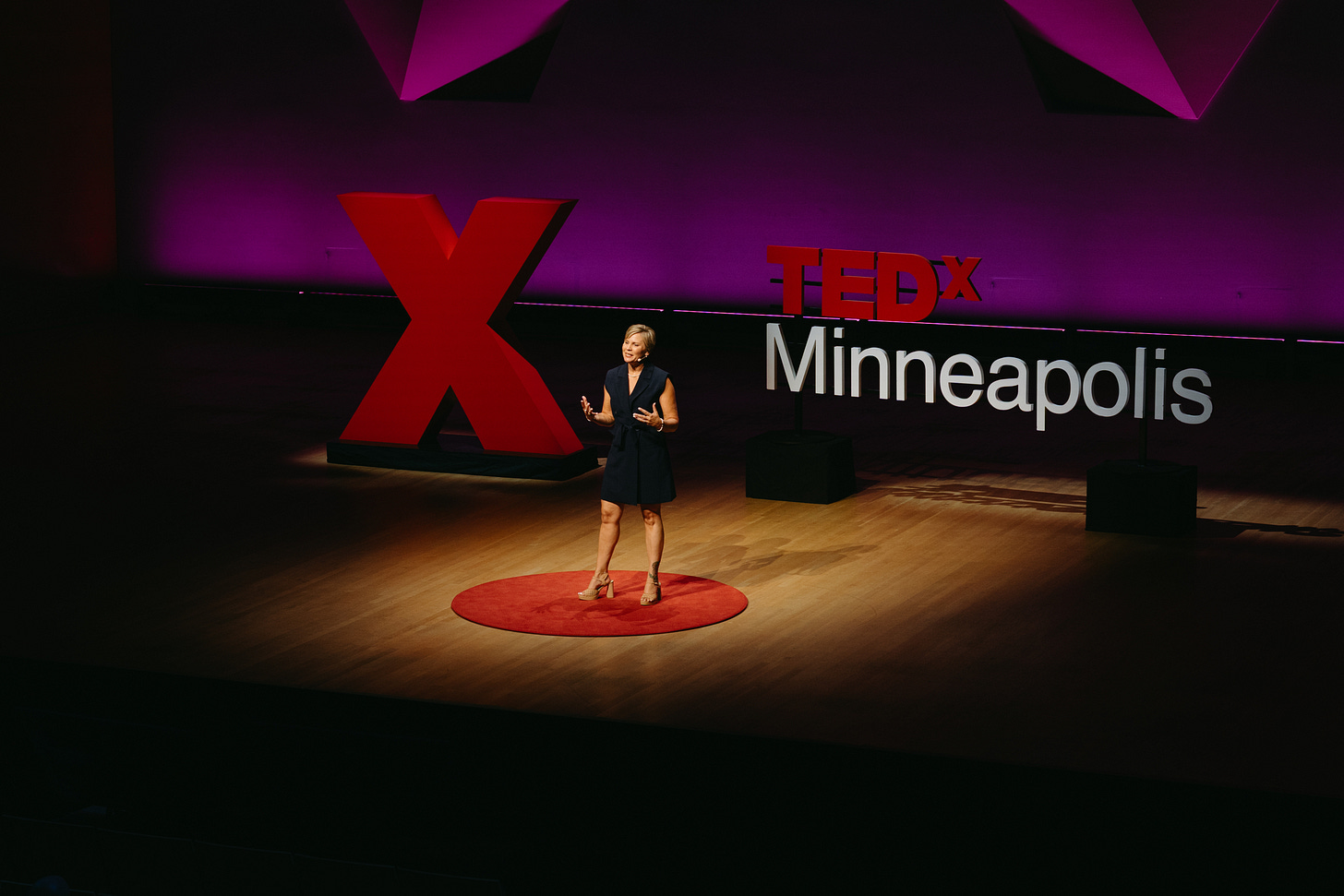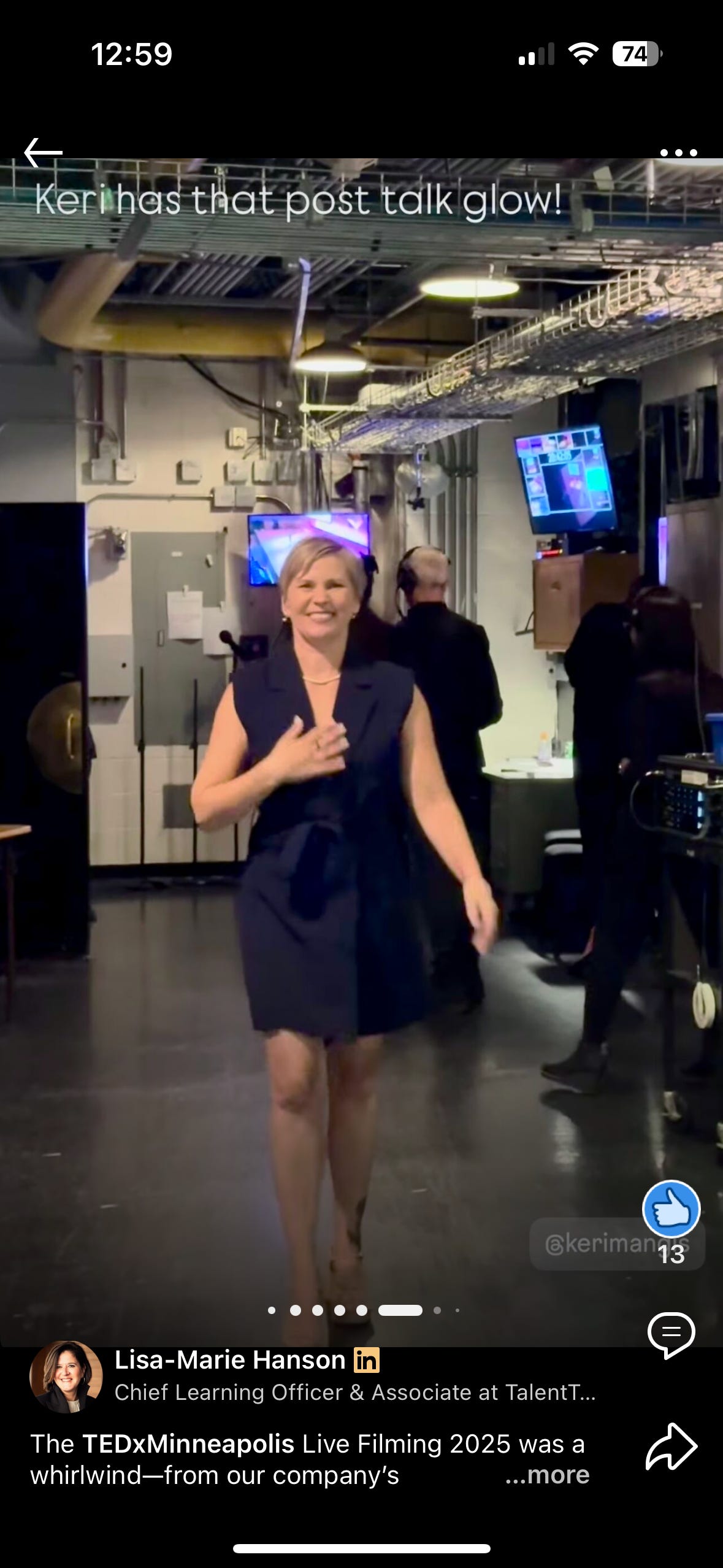Reflections on the TEDx Speaking Experience
Talking on menopause, elderhood, transitions, and rites of passage
Photo by Carter Kenneth for TEDxMinneapolis
Whew.
It’s been just a little over a week since I had the greatest of all opportunities to step on the red dot in Minneapolis, MN, for their 2025 TEDx event.
And I’m still coming down from the incredible high.
My talk was titled “Menopause as a Rite of Passage.”
The purpose was threefold, each benefit building on the one prior:
Normalize menopause.
Make menopause a part of everyday conversation — at dinner tables, in office spaces, and certainly, in doctors' offices.Offer a model to younger generations.
Without exception, every woman I’ve asked did not learn about menopause from her mother, grandmother, or doctor. We have all, instead, been relegated to learning about it as we go. But by making menopause visible, we can ensure that younger generations come to understand and expect this transition, rather than being blindsided by it.Build a culture of elderhood.
Menopause is, above all else, preparation for elderhood. As with any life transition, we need acknowledgement and recognition to be able to embody a new role or responsibility fully. Without any kind of recognition of menopause as a rite of passage, the new responsibilities of elderhood — mentorship, guidance, keepers of the knowledge — remain unclaimed. By creating a rite of passage around menopause, we allow for the possibility of women claiming this mantle and the responsibilities and leadership that come with it.
The Tedx Preparation
I’ve wanted to do a TED talk for many years. A bucket list item, you could say. This is because some of the greatest inspirations I’ve ever received have come from TED talks. And to get to add my name to the list of people who might offer that inspiration, well, that’s a Top 10 life experience. If you, like me, have imagined yourself standing on that red dot, I could not recommend taking the leap more.
Every TEDx (the x representing a locally and independently run TED event) experience is unique — from the audition process to the level of individual coaching you receive, and probably even to the quality of the talks and associated production. The Minneapolis event was highly professional, organized, caring, and thoughtful from the start.
As a writer, coming up with content to support my topic isn’t hard. What is challenging is paring it down to under 18 minutes (preferably less, mine ended up being 16). In other words, the editing.
This is where the coaches helped so much.
We had several checkpoints along the way, with action items coming out of each session. The intention was to tighten, strengthen, and ensure that we maintained our audience’s attention from beginning to end — no minor feat in today’s short attention spans and electronic distractions!
Iteration after iteration, we cut what was tangential and boosted what was primary until the talk felt well-rounded but not too dense or over-explanatory. Each time around, it felt more and more like the TED talks I’ve listened to for years.
Once the talk was refined, the work was to memorize it, word for word.
This was the part most of us speakers admitted we were worried about.
Most talks I’ve done in the past could either be from a general outline or with notecards if I wanted to say something in a very specific way. To memorize word-for-word 16 minutes of content? Could I do it?
I practiced daily for a good month, and then twice a day as we entered the final two-week stretch. I recorded myself and listened back to the recording while driving. I read it silently off the page, so I could see the transcript visually in my mind’s eye. Rinse and repeat.
I’m not exaggerating when I say this became my summer obsession.
Day in, day out, moment to moment, as the calendar days flew by, the space for any other creative work shrank. (So, prepare for this possibility if you’re thinking about it!)
Turns out, I could memorize 16 minutes. And I did. Because at some point, it became no longer about the memorization of words in order. It became about the repetition of a rhythm. Like a song you wouldn’t think you know all the lyrics to, but once the music starts, the words start flowing — that’s what it was like for me. The practice repetitions created grooves in my mind, perhaps like a habit — and we all know how much our brain loves a good habit!
Today I wonder: Will I still be able to recite this talk in a year? Five years? I will not be surprised if I can. It’s that ingrained now.
The TEDx Look
As I became more and more single-minded about the upcoming event, so too did I become obsessed about what I was going to wear on stage.
“Something that makes you feel fierce,” is what the coaches told us. And, of course, something that would not date the video, as it will live in perpetuity!
I thought about something really bold. I had a pair of high-heeled red shoes I seriously considered. But I finally settled on this simple blue dress for the very reason that it would not take center stage, allowing the topic to be what people talked about, not the outfit.
And then there was the make-up and hair, which I had done professionally.
“What look are you going for?” asked my makeup artist.
“Initially I was going for bold,” I told her. “But I’ve updated that idea to something timeless and elegant.”
“I know exactly what to do,” she replied, and she did.
Nails, jewelry…I thought through all of it, made it all part of a cohesive whole. I would never advise anyone to skimp on any of this.
The TEDx Stage
The night finally arrived.
One thing you don’t see in the TED videos is the announcement by the emcee and the solo walkout to the red dot. It was a pretty long walk from the right wings of the auditorium to the left side of the stage where the red dot was! But the walk would set the energy. Head up, confident steps…that’s what I told myself.
And then, I stood under the lights, looked out, and began this talk that I’ve been rehearsing for months.
There were roughly 600 people in attendance, the best crowd they had seen to date. I personally have never spoken for so many. But I knew I’d do what I always do: focus on a few people toward the front. And recite what I knew by heart.
Yet, there are some things you can’t rehearse for. Like laughter, reactions, or applause at places you didn’t anticipate. So welcome and appreciated, of course, but the mind says, “Will this disrupt my flow?”
But no. The repeated rehearsals did their job. And so did the many disruptions in my own household every time I practiced — my pets, other people, phone calls, knocks on the door — all of it served to teach me how to pick up at any point within the talk.
Once I realized that, I let go of any last worries and trusted myself. Trusted my talk. The fear evaporated. All that remained was joy. Fun. Engagement. And a sense that I was doing exactly what I was supposed to be doing — sharing an idea on the TEDx stage.
If you want to know how I felt immediately after I got off stage, well, the picture below does better than I can do with words.
If you have not gathered this by now, I could not recommend this process more. I learned so much about myself in these past six months. I know better what I am capable of. And the idea I shared…well, may it continue to grow and spread all on its own now that it’s been birthed in the world.
I am grateful for every step I got to take that led, ultimately, to the iconic red dot.
So if you have an idea or a story to share, find a TEDx event near you and apply! Or, go to a live taping in your area and get inspired!
I know that for me, the integration of this experience into my heart and words will last a lifetime.




